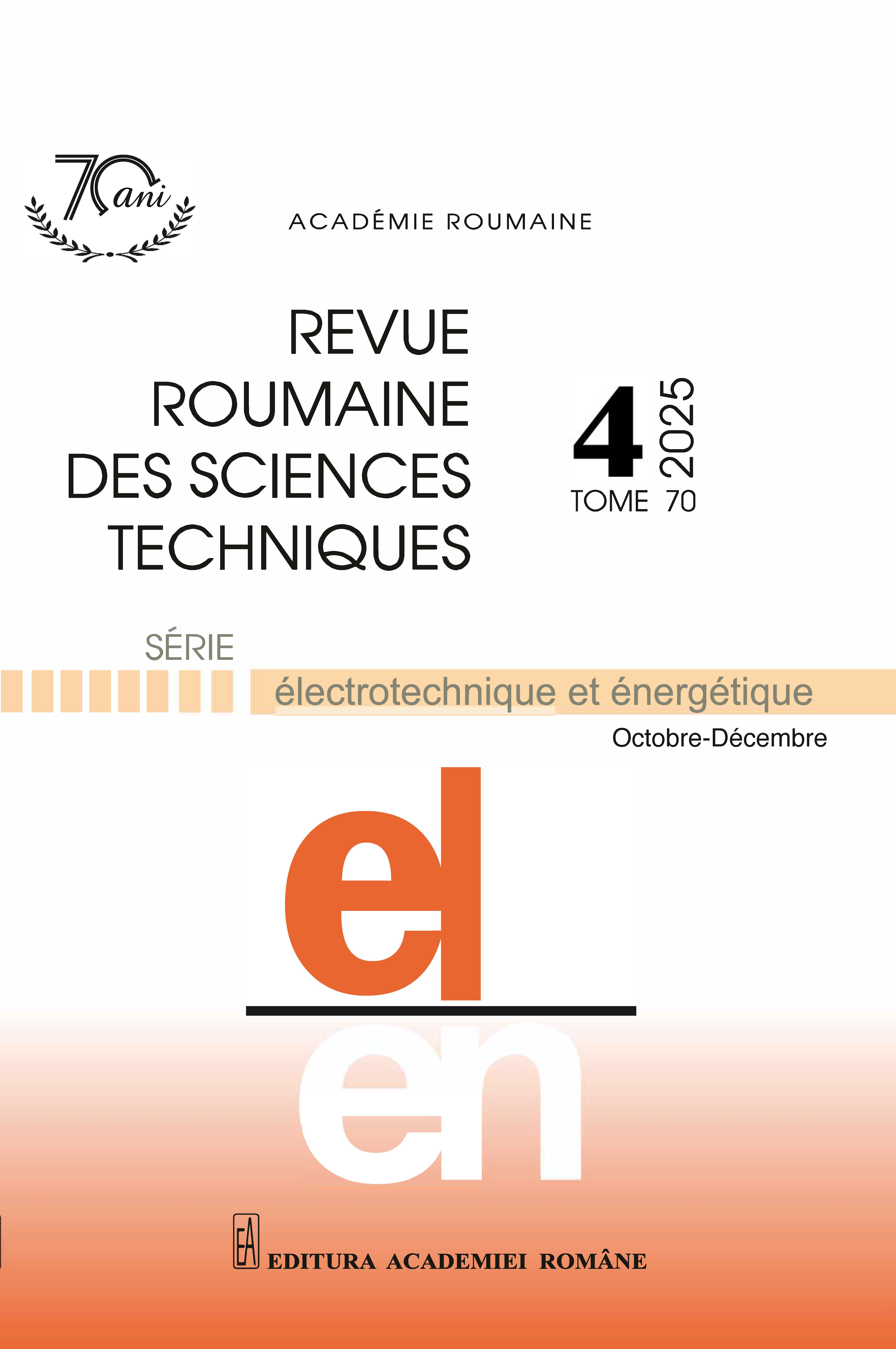RECONFIGURABLE INTELLIGENT SURFACE TUNED WITH NOMA FOR RESOURCE ALLOCATION
DOI:
https://doi.org/10.59277/RRST-EE.2025.4.24Keywords:
Heterogeneous network, Non-orthogonal multiple access (NOMA), Reconfigurable intelligent surface (RIS), Resource allocationAbstract
A reconfigurable intelligent surface (RIS) offers the potential benefits of 5G when combined with non-orthogonal multiple access (NOMA). As a result, the issues with distance, spectrum, and energy use worsen. Due to the limited energy supply, it is necessary to control the channel and achieve revolutionary energy efficiency that maximises both total rate and power optimisation. We jointly optimize the transmit power and optimal phase shift to mitigate the weak environment, thereby increasing the signal-to-noise ratio (SNR) and multiplexing data streams in the spatial domain. RIS arrays are used to form beams in the required directions. By decoupling the adjustable phase shift array elements, power allocation is performed using a low-complexity Dinkelbach method. The results are shown to provide practical solutions for users in different scenarios. The comparative results are shown to prove the novelty of the work and its significance.
References
(1) P. Swami, V. Bhatia, S. Vuppala, and T. Ratnarajah, User Fairness in NOMA-HetNet Using Optimized Power Allocation and Time Slotting, IEEE Systems Journal, 15, 1, pp. 1005–1014 (2021).
(2) M. Marinescu and M. Morega, Exposure of active medical implants bearers to electromagnetic emissions from wireless power transfer systems, Rev. Roum. Sci. Techn. – Électrotechn. et Énerg., 67, 2, pp. 213–218 (2022).
(3) H. Zeng, X. Zhu, Y. Jiang, Z. Wei, S. Sun, and X. Xiong, Toward UL-DL Rate Balancing: Joint Resource Allocation and Hybrid-Mode Multiple Access for UAV-BS Assisted Communication Systems, IEEE Trans. Commun., 70, pp. 2757–2771 (2022).
(4) M.R. Zamani, M. Eslami, M. Khorramizadeh, and Z. Ding, Energy efficient power allocation for NOMA with imperfect CSI, IEEE Trans. Veh. Technol., 68, 1, pp. 1009–1013 (2019).
(5) Y. Su, X. Pang, W. Lu, N. Zhao, X. Wang, and A. Nallanathan, Joint Location and Beamforming Optimization for STAR-RIS Aided NOMA-UAV Networks, IEEE Transactions on Vehicular Technology (2023).
(6) O. Maraqa, A.S. Rajasekaran, S. Al-Ahmadi, H. Yanikomeroglu, and S.M. Sait, A survey of rate-optimal power domain NOMA with enabling technologies of future wireless networks, IEEE Communications Surveys & Tutorials, 22, 4, pp. 2192–2235 (2020).
(7) J. Seo and Y. Sung, Beam design and user scheduling for non-orthogonal multiple access with multiple antennas based on Pareto optimality, IEEE Transactions on Signal Processing, 66, 11, pp. 2876–2891 (2018).
(8) Q.U.A. Nadeem, A. Kammoun, A. Chaaban, M. Debbah, and M.S. Alouini, Intelligent reflecting surface-assisted multi-user MISO communication (2019).
(9) C. Chih-Lin, C. Rowell, S. Han, Z. Xu, G. Li, and Z. Pan, Toward green and soft: a 5G perspective, IEEE Communications Magazine, 52, 2, pp. 66–73 (2014).
(10) A. Agçal, A. Kalay, and R. Cetin, Wireless power transfer for underwater vehicles, Rev. Roum. Sci. Techn. – Électrotechn. et Énerg., 68, 2, pp. 194–199 (2023).
(11) X. Cheng, Y. Hu, and L. Varga, 5G network deployment and the associated energy consumption in the U.K.: A complex systems’ exploration, Technol. Forecasting Social Change, 180 (2022).
(12) D. Zhang, Q. Wu, M. Cui, G. Zhang, and D. Niyato, Throughput maximization for IRS-assisted wireless powered hybrid NOMA and TDMA, IEEE Wireless Commun. Lett., 10, 9, pp. 1944–1948 (2021).
(13) A.M. Rajee, A. Merlin, and M.M. Yamuna Devi, Game Theoretic approach for power control in next generation Heterogeneous Networks, Signal, Image and Video Processing (2023).
(14) D. Zhang, Q. Wu, M. Cui, G. Zhang, and D. Niyato, Throughput maximization for IRS-assisted wireless powered hybrid NOMA and TDMA, IEEE Wireless Commun. Lett., 10, 9, pp. 1944–1948 (2021).
(15) S.A.M. Rajee and A. Merline, Machine intelligence technique for blockage effects in next-generation heterogeneous networks, Radioengineering, 29, 3 (2020).
(16) W.U. Khan, X. Li, A. Ihsan, Z. Ali, B.M. Elhalawany, and G.A.S. Sidhu, Energy efficiency maximization for beyond 5G NOMA-enabled heterogeneous networks, Peer-to-Peer Netw. Appl., 14, pp. 3250–3264 (2021).
(17) A.K. Varma, B. Kumar, A. Ramakrishna, and D. Mitra, Multi-hop relay selection for cooperative sensing in cognitive radio networks, Rev. Roum. Sci. Techn. – Électrotechn. et Énerg., 69, 2, pp. 237–242 (2024).
Downloads
Published
Issue
Section
License
Copyright (c) 2025 REVUE ROUMAINE DES SCIENCES TECHNIQUES — SÉRIE ÉLECTROTECHNIQUE ET ÉNERGÉTIQUE

This work is licensed under a Creative Commons Attribution-NonCommercial-NoDerivatives 4.0 International License.


